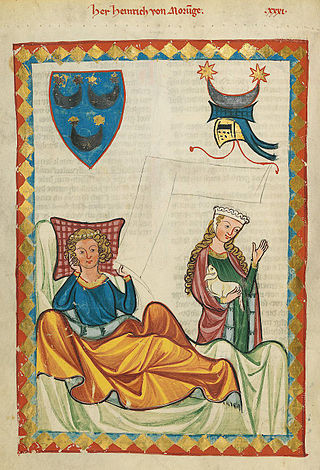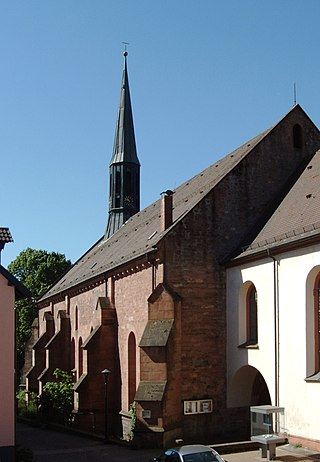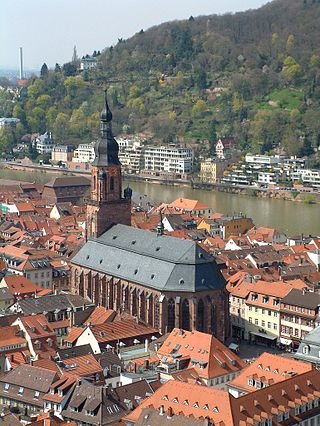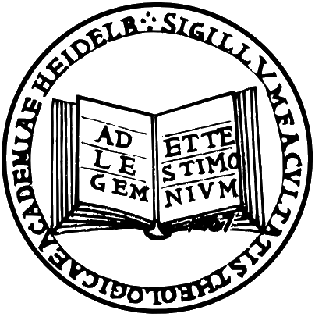
St. Peter's Church (German : Peterskirche) is the oldest church in the old town (Altstadt) of Heidelberg, Germany. It has generally served as the university church of the University of Heidelberg since the late Middle Ages.

St. Peter's Church (German : Peterskirche) is the oldest church in the old town (Altstadt) of Heidelberg, Germany. It has generally served as the university church of the University of Heidelberg since the late Middle Ages.
![St. Peter's Church in Johann Franz Capellini von Wickenburg [de]'s Thesaurus Palatinus (1747/52) Peterskirche Thesaurus Palatinus.jpg](http://upload.wikimedia.org/wikipedia/commons/thumb/d/d3/Peterskirche_Thesaurus_Palatinus.jpg/220px-Peterskirche_Thesaurus_Palatinus.jpg)

The earliest precursor of St. Peter's Church had already been built by the twelfth century, before the foundation of Heidelberg itself. It first appears in the sources in 1196 with the mention of a "plebanus Kunrad zu heidelberch, that is a parish priest named Konrad, based at Heidelberg. The church was donated by the Prince-Bishopric of Worms, since it possessed the area where Heidelberg was established. The name of the church indicates a connection with Worms Cathedral, which also stands under the patronage of St Peter. In 1225, the area was given to the Palatinate as a fief and Heidelberg was founded as a city. However, the church was left outside the walls of the newly founded city, which consisted of only the eastern half of the modern Altstadt of Heidelberg (the city walls were roughly in line with Grabengasse and Seminarstrasse. St. Peter's Church was the parish church of the city of Heidelberg until the construction of the larger Church of the Holy Spirit in the 14th century.
From 1400, St. Peter's Church, St Laurentius' in Altdorf bei Nürnberg, [1] and St. James' in Lauda-Königshofen [2] were the proprietary churches of the University of Heidelberg; they were withdrawn from the control of their diocesan bishops and placed immediately under the authority of the Pope. The Holy See entrusted administration of these parishes to the dean of the Stiftskirche, Neustadt an der Weinstraße , Heilmann von Wattenheim (died 1411), who was thereby essentially promoted to the status of a Papal archdeacon. The university's patronage of the three churches lasted until the beginning of the Reformation, when the church became Protestant. [3]
After Maximilian I took power in Heidelberg, the Dominican Johann Andreas Coppenstein served as Catholic parish priest of the church from 1624 to 1630. He was a famous theological writer and sought to reorganise Catholicism there, without success. [4]
After the Badian union of the Lutheran and Calvinist churches in 1821, St. Peter's Church lost some of its significance.
Since 1896, the church has been the university church of Heidelberg.

The original appearance of the church is not known. Between 1485 and 1496 it was rebuilt in the late Gothic style and greatly expanded. The foundation stone of the new structure was laid on 16 March 1485 by Alexander Bellendörfer (died 1512), the chancellor and prothonotary of Electoral Palatinate, whose epitaph is also preserved in the church. While evidence for late Romanesque and High Gothic predecessors is lacking, the late Gothic structure remains an important component of the modern church (walls of the choir and nave). In 1496, two chapels were added to the nave on the north and south sides. The sacristy was built later on the south side.
The destruction of the city in 1689 and 1693 left the church a burnt-out ruin with the stump of a tower. The interior was rebuilt in the style of a baroque aisleless transept church.
Thanks to the support of the university the money which the church had received from the sale of its lands to allow the construction of the Odenwald railway in 1859/60, the church was heavily renovated from 1864 to 1870, under the direction of Ludwig Franck-Marperger, in the form of a three-aisle hall church in the then-dominant Neo-Gothic style. Only the choir, the old sacristy, and the university chapel retain their Medieval appearance. In 1883, the 400th birthday of Martin Luther, a Luther oak was planted in his honour. For the university's jubilee in 1884, the church's tower was remodelled in the form of Freiburg Minster. To protect the filigree spire from weathering, it was subsequently covered over with a copper roof.
In 2004/5, an elaborate renovation of the interior was carried out, including a new altar, pulpit, baptismal font, Easter candlestick, and a free-standing cross in the choir, made by the artist Matthias Eder out of COR-TEN steel. In July 2006, four new church windows were installed by the glass-artist Johannes Schreiter. Three windows are located in the southern side-chapel, the "University chapel" with the themes of "encounter," "resurrection," and "persecution." In the northern side-chapel, which serves as a space for prayer and meditation, is a window with the theme of "peace." In March 2008, a modern sculpture of Jesus by the Korean artist Lee Choon-Mann was installed there.
From January 2010, the drafts of five windows were present in the nave. The three largest windows were "Holy Spirit" and "Baptism" on the north side and "Heavenly Jerusalem" on the south side. Two smaller windows were made with the themes of "Worth" and "Sacrament". These five windows were installed between November 2010 and July 2012, completing a cycle of nine windows by Schreiter.

It is owned by the Protestant Association for the care of Schönau , but is not located in any parish. Instead, according to the agreement of 1896, it serves as the church of University of Heidelberg.
The church hosts Protestant University church services on Sundays and religious holidays, as well as numerous concerts. Members of the Heidelberg theological faculty and the parish priests of the Protestant Student Society (ESG) of Heidelberg. Responsibility for university services is held by the university priest, who is elected by the ministerial convention that contains all ordinary members of the Theology faculty, in partnership with the chapter elected by the society. The church is also the site of public discussions ("Peterskirchendialog"), with speakers including Nikolaus Schneider (2011), Günther Beckstein and Konstantin von Notz (2012), Wolfgang Huber and Volker Beck (2013), Franz Müntefering (2014), Ralf Kabelka and Gisela Matthiae (2015), Olav Fykse Tveit, Ralf Kabelka , and Ralf Kabelka (2016), and Martin Dutzmann , Peter Scheben, Klaus-Dieter Ordemann and Kiflemariam Gebrewold (2017). It also hosts the "Academic lunchbreak" (Akademische Mittagspause) on weekdays during the university term, at which short academic presentations are delivered for a general audience. [5]
Numerous professors are buried in the church, including Marsilius of Inghen, the founding rector of the university. His grave is no longer preserved, but in 2011 625 graves were. At the university's jubilee, a plaque was set up in the side chapel of the University for Marsilius. There are around a hundred and fifty epitaphs of university professors and members of the Electorate court on the inner and outer walls of the church. An honorific plaque in the southern side chapel commemorates the poet and humanist Olympia Fulvia Morata. The partially preserved church cemetery was the main cemetery of the city while it lay outside the city walls. At the southeastern corner on the outside there is a university plaque commemorating the victims of war and tyranny. This is also the site of the gravestone of the Swiss textile merchant Hans Jacob Rieter , who was beaten to death in a robbery in 1811 by Hölzerlips ' gang.

The organ of St. Peter's Church was built by the organ firm Klais Orgelbau (Bonn) in 1984. The instrument has 34 stops in three manuals and pedal keyboards. The tracker action is mechanical. [6]

Heinrich Frauenlob, sometimes known as Henry of Meissen, was a Middle High German poet, a representative of both the Sangspruchdichtung and Minnesang genres. He was one of the most celebrated poets of the late medieval period, venerated and imitated well into the 15th century.

Hildesheim Cathedral, officially the Cathedral of the Assumption of Mary or simply St. Mary's Cathedral, is a medieval Roman Catholic cathedral in the city centre of Hildesheim in Lower Saxony, Germany, that serves as the seat of the Diocese of Hildesheim. The cathedral has been on the UNESCO World Cultural Heritage list since 1985, together with the nearby St. Michael's Church because of its unique art and outstanding Romanesque architecture.

Heinrich von Morungen was a Minnesinger, whose 35 surviving Middle High German songs are dated on both literary and biographical grounds to around the period 1190–1200. Alongside Walter von der Vogelweide and Reinmar he is regarded as one of the most important Minnesänger: he was "the most colourful, passionate, tender and musical of the Minnesänger" and his work "marks a new and brilliantly effective stage in the development of the German lyric."

Regensburg Cathedral, also known as St. Peter's Cathedral, is an example of important Gothic architecture within the German state of Bavaria. It is a landmark for the city of Regensburg, Germany, and the seat of the Catholic Diocese of Regensburg.

Schönau Abbey in Schönau in the Odenwald, in the Rhein-Neckar-Kreis in Baden-Württemberg, was a Cistercian monastery founded in 1142 from Eberbach Abbey. The present settlement of Schönau grew up round the monastery.

The Church of the Holy Spirit is the largest church in Heidelberg, Germany. The church, located in the marketplace in the old town center, was constructed between 1398 and 1515 in the Romanesque and Gothic styles. It receives 1–3 million guests annually, making it among the most visited churches in Germany.

Breitenwang is a municipality and village in the district of Reutte in the Austrian state of Tyrol.

The Heidelberg Faculty of Theology is one of twelve faculties at the University of Heidelberg. It was one of the four founding faculties in 1386. As of 2023, the faculty's dean is Jan Stievermann.

The Heidelberg University Library is the central library of the Heidelberg University. Together with the 83 decentralized libraries of the faculties and institutes, it forms the University Library System, which is headed by the director of the University Library. The University Library holds special collections in literature concerning the Palatinate and Baden, egyptology, archeology, the history of art, and South Asia. It holds about 3.2 million books, 6,000 printed scientific periodicals, and about 500,000 other media such as microfilms and video tapes. The libraries of the faculties and institutes hold another 3 million printed books. In 2022, the University Library registered 43,600 active users who accessed more than 746,000 books. The conventional book supply is complemented by numerous electronic services, including approximately 152,00 electronic journals. The University Library provides around 1,100 reading- and workspaces in the main library in the old town and around 320 reading- and workspaces in the branch in the Neuenheimer Feld, including many IT-workstations and research stations equipped with PCs.
Martin Weber was a German architect who designed Catholic churches.

Andreas Urs Sommer is a German philosopher of Swiss origin. He specializes in the history of philosophy and its theory, ethics, philosophy of religion, and Skepticism. His historical studies center on the philosophy of Enlightenment and Nietzsche, but they also deal with Kant, Max Weber, Pierre Bayle, Jonathan Edwards, and others.

Henry Keazor is a German art historian. He is a professor of art history at Heidelberg University.

Old St. Peter's Church is a Lutheran parish and church in the old town of Leipzig, Germany. The present church building, in Gothic Revival style, was erected from 1882 onwards at the Gaudigplatz, and also serves as a concert venue. It replaced a former building at a different location.

The church St. Peter und Alexander is a Catholic church located in Aschaffenburg, Bavaria, Germany. It is the town's oldest church, established in the 10th century, dedicated to Saint Peter and Saint Alexander. The main building was built as a Roman basilica, while other phases were built in the early Gothic style. The current structure is a cruciform basilica, reflecting a variety of styles including a Romanesque nave from the 12th century and a 15th-century tower.

St. Leonhard is a parish of the Roman Catholic Church in Frankfurt, Hesse, Germany. Its historic church dates to 1219, when it was erected in the centre of the town close to the river Main, as a Romanesque-style basilica. From 1425, it was remodeled to a hall church in late Gothic style. St. Leonhard was the only one of nine churches in the Old Town that survived World War II almost undamaged. Today, the parish is part of the Domgemeinde and serves as the parish church of English-speaking Catholics. It is a monument of Frankfurt's history as well as church history and medieval crafts.
Florian Steger is a German medical historian and medical ethicist.

St. Wendel is the name of a Catholic parish and church in Frankfurt-Sachsenhausen, Hesse, Germany, dedicated to Wendelin of Trier. The official name of the church is Kath. St. Wendelskirche. It was built from 1955 to 1957, designed by architect Johannes Krahn.

Halle Cathedral is an Evangelical Reformed Church, and is the oldest surviving church in the old part of the city Halle, Saale. Beside it resided the Archbishop of Magdeburg, who ruled the city for a long period. Albert of Brandenburg remodelled the church's exterior from 1520 onwards and built the neighbouring Neue Residenz, aiming to make the church one of the most influential and powerful monasteries north of the Alps.

St Peter's Church is a Roman Catholic church in Cologne, run by the Jesuits. The painter Rubens was baptised in the church and his father was later buried there. Rubens' Crucifixion of St Peter is on display in the church. It was commissioned in 1638 by the Cologne art collector and businessman Eberhard Jabach and was hung in the church in 1642 after Rubens'death. The building also houses the 'Kunst-Station Sankt Peter', a centre for contemporary art, music, and literature.
Johannes Schreiter is a German graphic artist, printmaker, designer of stained glass, theoretician and cultural critic. Born in Buchholz in 1930, Schreiter studied in Munster, Mainz, and Berlin, before receiving a scholarship from Friedrich-Ebert-Stiftung in 1958. His invention of the Brandcollage in 1959 first brought him to broader cultural attention, and in 1963 he became professor of Painting and Graphic Art at the Frankfurt/Main School of Decorative Arts, and later Rector of the same. He was awarded the Bundesverdienstkreuze, the highest civilian honour granted by West Germany, in 1979.